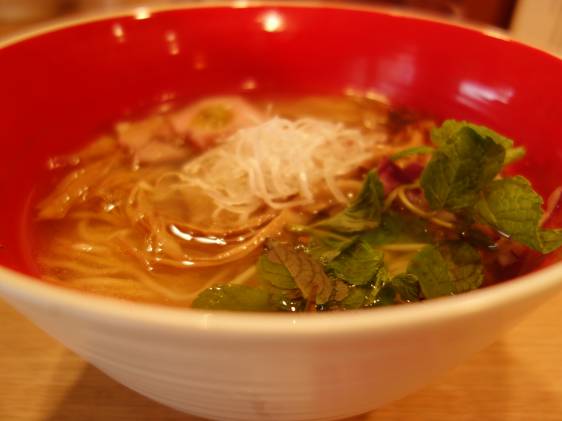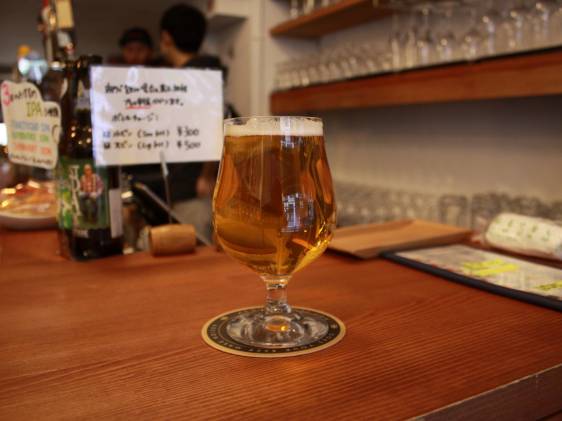Note: This restaurant has relocated to Yoyogi-Uehara. Tickets are no longer required. See the official website for more details before visiting.
Long queues, truffle oil, soba made in-house and a handy Twitter account. Add it all together and what have you got? Tokyo’s Michelin-star ramen joint Tsuta—the best addition to your Japan bucket list.

After receiving the coveted French honor in December, Tsuta had to decide how to adapt, and fast. Already popular and well respected, the queues soon reached the hundreds and getting a bowl of their ramen was a daunting task requiring serious dedication. Having chosen to stay in its small-but-smart 9-seater restaurant and even closing their second shop, it was the queuing that had to change. Fast forward to this summer, and thanks to Twitter, some new signs and a simple but efficient ticket system, it just takes an early start and some flexibility to try what is deemed the best ramen in the world, and it’s well worth it.
Getting In
Depending on where you’re staying, Sugamo (aka “obasan Harajuku“) is an easy enough station to reach as it’s on the Yamanote line, but can take a while. Once there however, you’re mere minutes from Tsuta. The ticketing system has been developed into a two-stage process: first you get your time-slot-tickets and then later you return for ramen, and although it means you’ll have to make two trips, there’s less queuing and more time to get on with your day in-between. With short business hours, slots run from 11am until 4pm, so keep in mind that this is a day-only affair.
Round One: The Tickets

Tickets are available at 7am on a weekday and 6.30am on weekends, usually selling out by 10am. You can even follow their progress on the dedicated Twitter account which is updated a few times a morning and when tickets are finally sold out.

I arrived on a regular Thursday morning at 8am and got tickets for the 2pm slot. The best change is that there is now no limit on tickets per person, which means one unlucky soul can take one for the team (me), and the others can stay in bed and enjoy dreams of the ramen to come. You do have to pay a 1000yen deposit for each ticket to ensure you come back, but this is returned directly rather than being off-set against your meal. The tickets are color coded and there’s a guide to let you know when to come. So, head off and enjoy your day until its Michelin ramen time!

Round Two: Entry

Fancy seeing you here. So, tickets in hand and stomach rumbling, you arrive at your allotted time. This isn’t your seating time though (sorry), this is your queuing time. So what to do—enjoy the garage scenery? Maybe. Or glare at your friends if they even dare raise an eyebrow at waiting and remind them readily of your previous sacrifice (because you’re nice like that). However you decide to pass the time, just know it will be worth it. It’s actually only about half an hour, so don’t worry (and the man in the picture is definitely not in the throes of despair, I think he was yawning). There are some instructions to read as you edge your way around at least.
Once you reach the end, you’ll trade your ticket for your deposit, and be lead into the promised land….
The Ramen
So, this is probably the most difficult part of the entire experience: choosing which of the amazing options to enjoy. I can try and help, (but also not help) by saying they are all absolutely delicious (descriptions further down). It is actually soba, but served as ramen—so don’t panic if you can’t see ‘ramen’ anywhere.

The standard vending machine is here, but with all options available in English, so fear not—you won’t accidentally order the wrong thing (although somewhat impossible as it’s all great). You hand over your small white ticket, take a seat on the side until a place is ready (only three at a time are allowed in to order and wait, so be prepared for groups to be split). Be aware though, that photos of the kitchen are not allowed. Distract yourself with the Michelin awards on the water cooler and otherwise just stare at the chefs like some creeper, reciting facts in whispers to friends…or maybe that was just me. (The owner quit a career in fashion traveling the world to train at his father’s ramen shop in Kanagawa before he achieved his dream of his own shop though! Just saying.)

Finally, you will be seated with some simple stylish place settings, and a view of the chefs as they dish up your long-awaited bowl of joy.
We tried both shoyu ramen (soy sauce) and the shio ramen (salt) and couldn’t pick a favorite despite much trading of spoons. (We didn’t have the Tsukesoba purely so we had an excuse to return.) One of the lovely things about the ramen here is the choice of ingredients from all over Japan, along with those from abroad, ensuring the best of ingredients.

The lighter shio ramen uses a clam and red-seabream-based dashi, blended into a shio soup which uses salt from Mongolia and the seas of Okinawa. Topped with fresh onions, mint and white truffle sauce, this is the lightest and most aromatic (and insanely delicious) ramen in existence. The seafood base complemented and enhanced without being overpowering. The soup is so clear and fresh, it’s a joy to eat, with none of the fattiness or regret that can often follow downing a bowl of ramen. Also, it’s nowhere near as salty as usual, balanced so you don’t need to drink half a lake after.

The shoyu-ramen is made with a mixed chicken and seafood stock including pike from Mie and kelp from Hokkaido combined with a blend of a white soy sauce, a natural soy sauce from Wakayama and a third sourced from Nagano. The dish includes red wine and Italian black truffle sauce perched on the melt-in-the-mouth chashu. The flavors blended delicately and managed to be full without being overpowering, and I kept stealing spoonfuls to try and pin down what made it so delicious—the verdict was mushroom and what can only be described as witchcraft.
The Michelin guide describes the shoyu tsukesoba as having a “memorable porcini mushroom fragrance” and I can’t wait to go back to try it. The wholewheat noodles made in-house are thin but firm. Ramen enthusiasts claim you should eat your bowlful in no more than 7 minutes to prevent noodles going soft, and with flavors this good, the battle between savoring and slurping is strong.
So, once you have slurped your way through your bowl, stolen from friends and mourned the fact that you have to return to normal food, you can skip out feeling full but light. The love hotel opposite might suddenly seems like a practical choice for your next return…

- 102 m from Sugamo Station Mita Line (I15)Yamanote Line (JY11)
- 0.7 km from Komagome Station Namboku Line (N14)Yamanote Line (JY10)
- 0.7 km from Sengoku Station Mita Line (I14)
Get the Top Tokyo Cheapo hacks in your inbox.
Nearby restaurants and cafes
-
Slow ecolab
Slow ecolab is a café and community space set up by the founders of Ekolokal, a community to encourage eco-friendly …
-
-
-
Titans Craft Beer Taproom & Bottle Shop
Titan’s Craft Beer Taproom is a surprisingly large craft beer bar located just 30 seconds walk from the south …
-






